At the Skoll Foundation much of the work we support—and the stories we seek to tell—has to do with organizations and movements seeking to protect the environment and indigenous land rights. Social entrepreneurs like the Amazon Conservation Team work to empower tribes to protect their land in the Amazon rainforest, and other such as Landesa partner with governments and local organizations to ensure that the world’s poorest families have secure rights over the land they use for agriculture.
To better understand first-hand an important environmental and land rights struggle here and now in America, our videographer Gabriel Diamond packed up his camera and headed to North Dakota, where the Standing Rock Sioux tribe and others have been protesting the construction of the Dakota Access Pipeline.
I came to try to help tell the story from the ground, but there is no one story to tell. I heard so many. Here’s mine.
Due to high demand, there were no rental cars available in Bismarck (the closest town with an airport to Standing Rock), so I figured I’d wing it, and try to catch a ride with someone (and hopefully find a safe place to store my gear and sleep). For some strange reason my phone time did not update to mountain time during my layover in Denver and I missed my connection. Conspiracy theories abound about cell phone hacking. LOTS of strange phone behavior there. There was no room for me on the next flight, so I flew to Fargo instead. This was a mixed blessing, since they had cars. I drove till about midnight, slept, then drove to Bismarck airport in the morning to pick up my checked bag.
At the airport I asked around if anyone needed a ride to Standing Rock. There was a veteran named Tim who took me up on the offer. He was 27, from South Carolina on permanent disability “retirement” with severe PTSD after having his truck blown up by an IED in Afghanistan. This was his first political action. He had a wife and three kids, and was very quiet and reserved. As we neared the camp and saw the long line of cars in front of us waiting to enter, and the fence strewn with handmade signs and messages he said “This is actually really moving. And that’s coming from someone who doesn’t like to talk about his feelings.”
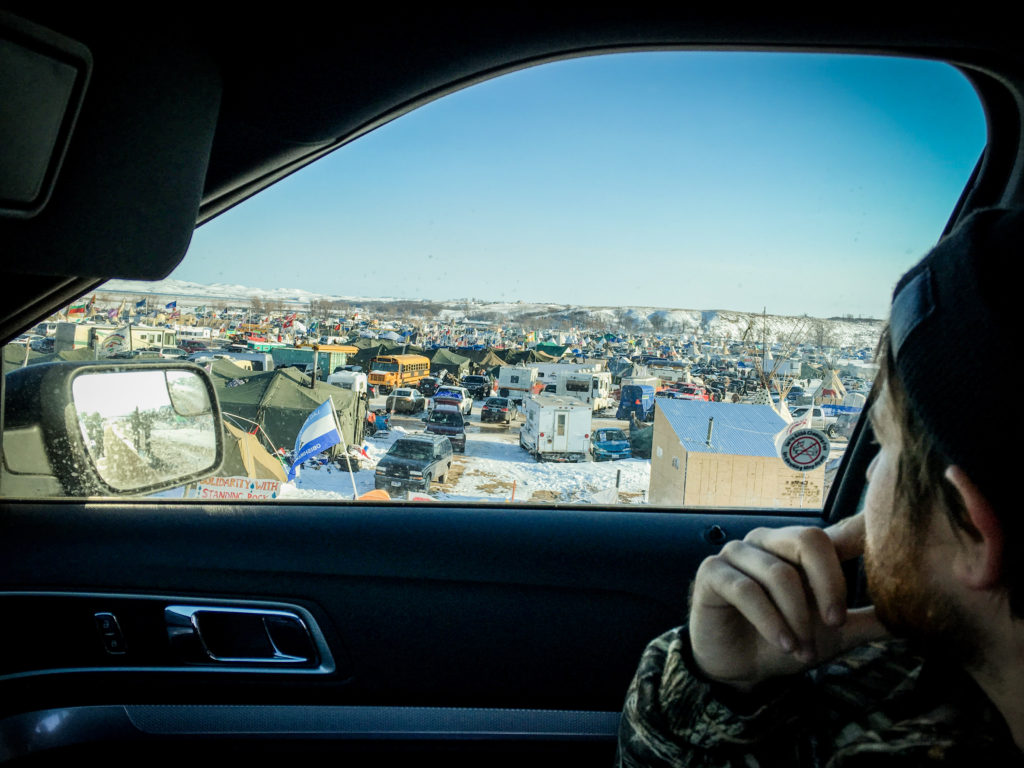
One of the first people we saw was an old housemate of mine Alex, who was hard at work building a straw bale school house in Sacred Stone Camp.
Over the next few days I met people from all over the world, many religions, ages, and races. Each person clearly had come at great sacrifice. Many had left their jobs and given up their homes and had no intention of going back until DAPL backed down. I have never felt such communal camaraderie and generosity of spirit in such a large group. When someone slipped on the ice (which happened constantly) many folks would run to their side to help them up. One lady brought a truck load of ice cleats that slip on over boots, she gave me a pair. I gifted them back to someone after I left. That’s how it is there.
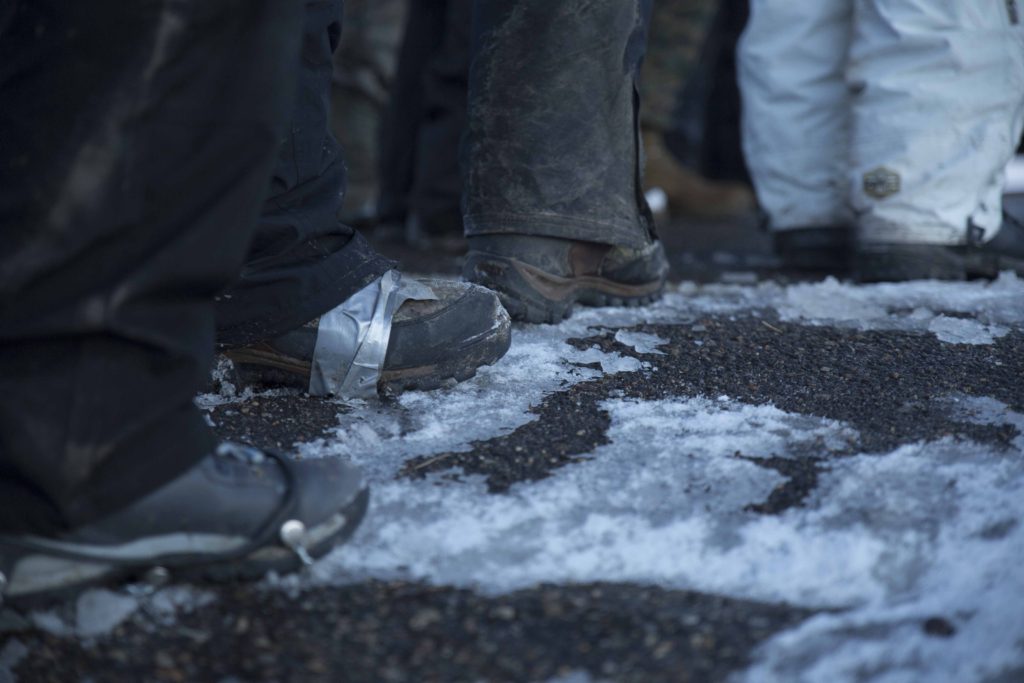
At each moment I was aware that I was a white man coming to extract something (not oil or gold, but stories) from a land and people with a long history of that relationship. I was met with a mix of weary distrust and welcoming kindness. The relationships were clearly strained.
Upon first arriving, at the mandatory orientation (held every morning at 9AM), we were urged to put our personal agendas aside. To slow down, to listen, to pray, to resist telling people your opinion or idea about how things should be done, that most of us had the luxury of leaving, and if we made rash decisions the natives who live on the land would be left to clean up after us. They had been fighting this fight for hundreds of years, and knew about patience. Learn from that. Be of service, look for ways to help. Everyone was a volunteer. Everything had been done on the fly. There were several large communal kitchens and mess halls, with people cooking and cleaning constantly. I arrived on the weekend with thousands of others, many of them vets. I heard that the camp had doubled in size over a couple weeks.
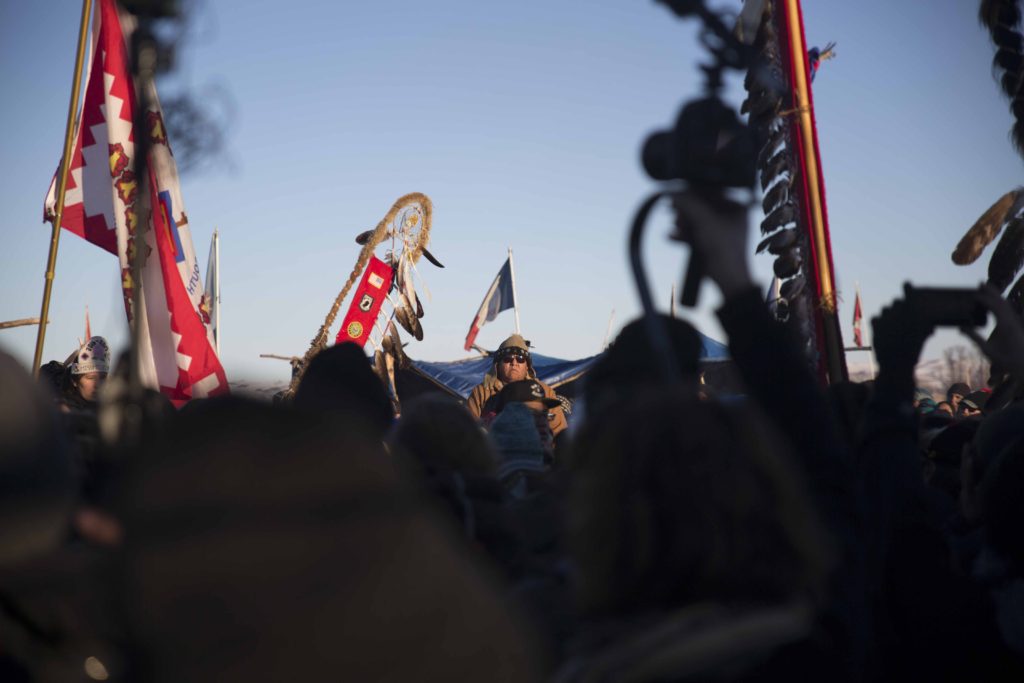
The first step was to get a media pass, which took nearly 24 hours (label shortage, long lines). Without the pass people would stop me constantly if they saw my camera, telling me I needed to get one. There was a lot of media present. I began to feel some shame about my purpose there, hoping to get an interview with an elder, yet having no formal introductions, or relationship and trust built. They were reluctant.
In my normal filmmaking world I feel like I have a golden ticket, and everyone is grateful for my presence and the opportunity to have their story told to a wider audience. Here there was media fatigue, and I just added to the noise. Looking through the photos I took, every time there was a photographer in my shot it felt like it was ruined, less authentic somehow. I’m sure my presence ruined many other photographer’s shots.
I also noticed my reluctance to photograph white people, which was nearly impossible to avoid. It’s hard to show it’s an indigenous-led movement when most of the people are white. Had the movement lost its soul, or just been overwhelmed with white people and media? Had the great white hope ruined what it sought to save? I just read a press release that a Sioux Chairman asked all non-Sioux to leave yesterday. Wow. This was after the news that “Obama Halts Pipeline” although it appears that’s merely a bureaucratic inconvenience for DAPL (Dakota Access, an Energy Transfer Partners subsidiary) who intend to continue to build as planned. Will the the non natives leave now? Many I met intend to stay for the long haul.
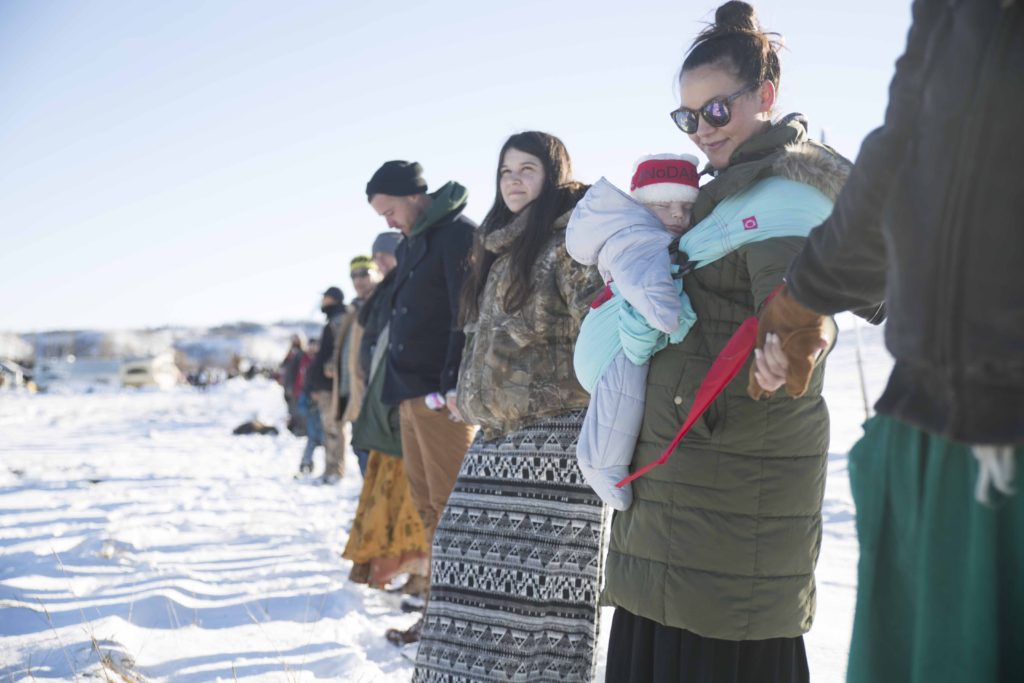
I took a break from filming and joined a discussion in the dome where people proposed topics to discuss and then break into groups. The group I joined was called “Passing Privilege”. People talked about being mixed race, being allies, correcting unacceptable behavior with love. It was personal, honest, and radical. People were there to educate themselves and share, and heal.
Like the Occupy movement there are many factions and in fighting. I took things slow, and was never pushy when asking for interviews, etc. The reception I received was kind and gracious. Perhaps because I’d been advised to always offer tobacco to elders as a sign of respect, to approach slowly, and seek permission to speak, or perhaps they could recognize my 1/8th Athabascan roots…
Flag waving was a big deal. People wore their experience and lineages on their sleeves in a way I have never encountered. As a white male I was keenly aware that I was on the bottom of the totem pole, so to speak.
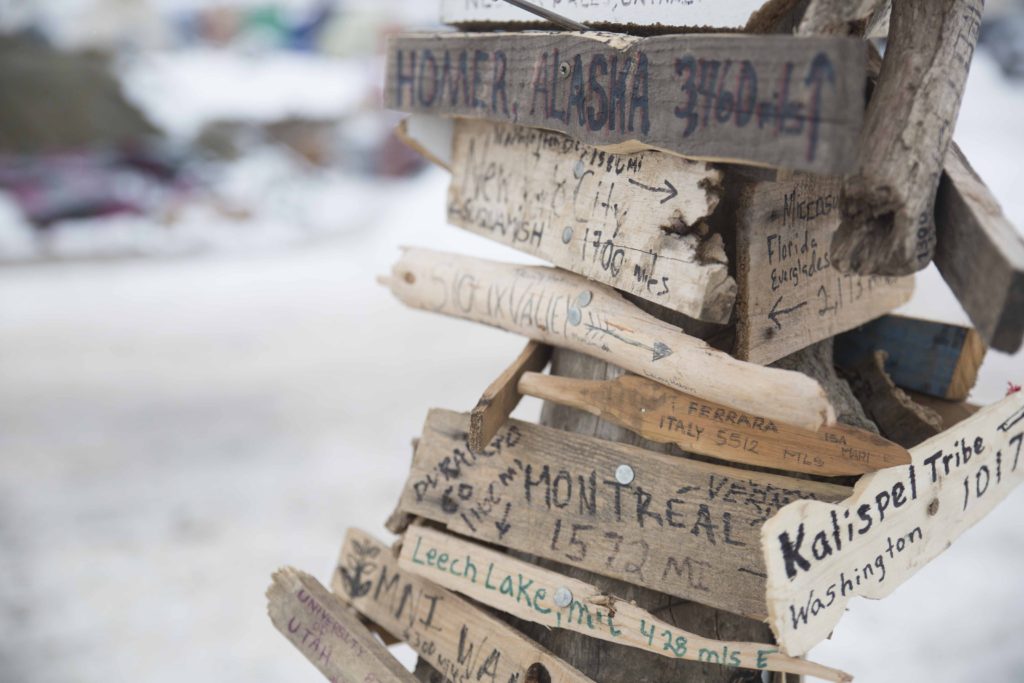
I was on the ground for 3 days. I slept in the car in Oceti Camp (the big one, there are several). I could have slept in one of the communal heated tents, but my bag was warm and those tents were crowded and I didn’t want to take up the space. It was beautiful to see the donations flood in. There was a tent where supplies were distributed to those in need. I spoke to someone who worked in that camp who said she noticed that many of the natives wouldn’t ask for supplies even though they were clearly under resourced, while other people with expensive gear would come in asking for other expensive gear.
There was work to be done all around, all the time, meals to cook, cleaning, picking up trash, building… I helped put a tarp over the hole at the top of a tipi (to keep the snow out) for a Sioux from Standing Rock named Lone Wolf.
During a march with the vets to the front line (but not up to the bridge, which was considered a truce area where Water Protectors and police had both agreed not to go) the snow started to come down hard. Blizzard conditions. It was then that it began to sink in what the next couple months were going to be like. Brutal.
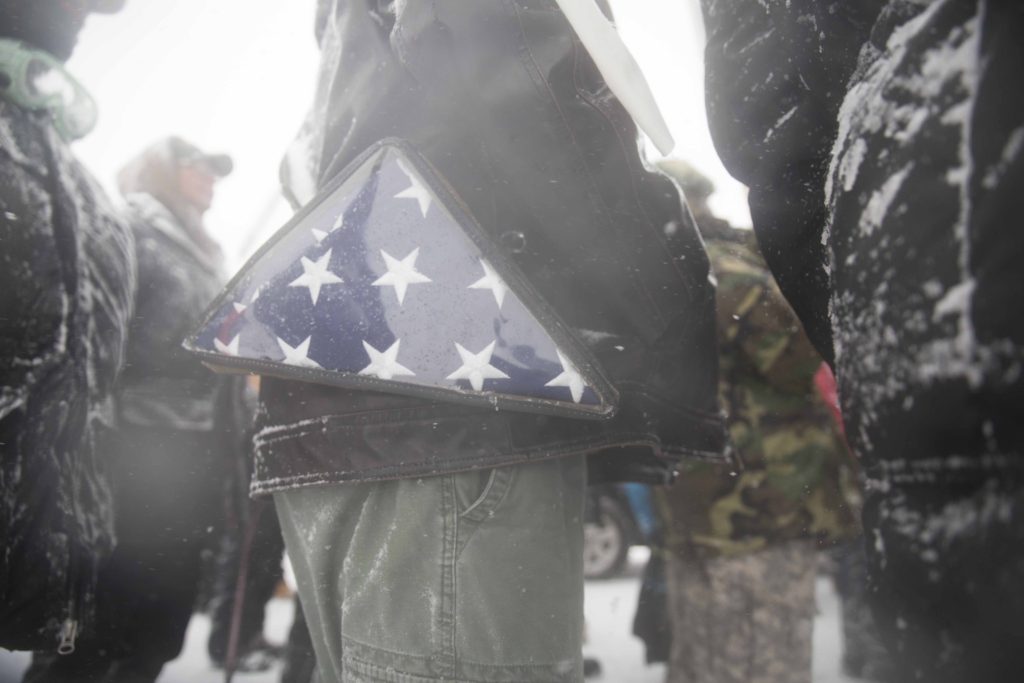
At the sacred fire there’s a man with a megaphone who makes announcements. I offered a ride to Bismarck, moments later three people emerged to take me up on the ride. Then we heard the roads had been closed due to the weather. Two of us ended up leaving anyway. It took 4 hours to drive what usually takes 1.5. There were cars stuck and spun out all along. We took it slow. We found the last room in Bismarck. Then 4 more people joined us. I slept on the floor so an elder could have the bed. For once I really felt that that I had been of service, since those four had been about to sleep in their seats in their car.
At the airport I found some people who were heading back to camp and gave them some unused supplies. I sat next to a vet on the plane, bookending my trip.
So much more I could say, especially with the news that DAPL is still drilling, but I’ll let these pictures speak for themselves…